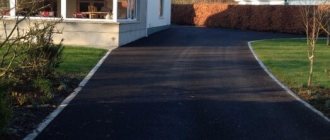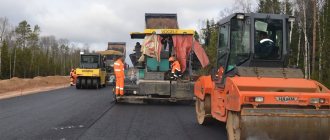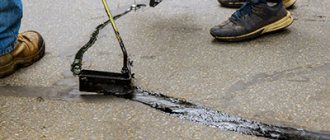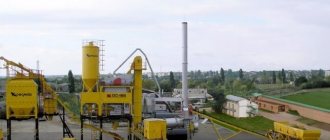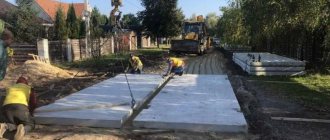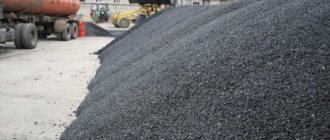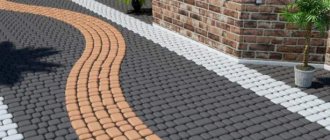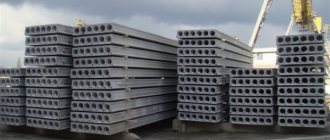- Road paving
- /
- News
- /
- Asphalt pavement thickness
The durability of asphalt pavement depends on its thickness on the road, site or near the house, that is, its intended purpose in accordance with the loads. For this, there are special road construction standards, which indicate the thickness of the entire “pie”: sand, crushed stone, asphalt concrete pavement.
Construction of sidewalks made of asphalt and asphalt concrete
Asphalt concrete is a modern, reliable material that is used for landscaping urban and private areas.
Asphalt is used for sidewalks, laying driveways, road surfaces, playgrounds, etc. Asphalt concrete coatings are characterized by high quality, strength and durability. When laying asphalt concrete sidewalks, special importance is given to the choice of material, design of work and technology for constructing the sidewalk. As a result, if all rules and requirements are followed, you will get a comfortable and safe coating that will last for many years.
Below we will look in detail at typical designs of sidewalks made of asphalt concrete, find out their advantages and disadvantages, and also analyze the technology of laying sidewalks with our own hands.
What thickness of asphalt should be on the road
The thickness of the asphalt pavement according to SNiP must correspond to the purpose of the asphalted area. There are specific standards and technologies for asphalting the site of a private house, parking lots, and highways.
Thickness of asphalt laying in a private yard
In the courtyard of a private house there is no need for a multi-layer canvas, since this area is not intended for the movement of cars or heavy equipment. According to GOST, the thickness of the asphalt laid in the yard must be at least 4 cm. If these requirements are violated, after winter the coating will crack and repairs will have to be made. Before asphalting, workers must level the area and make a sand-crushed stone base.
Thickness of asphalt pavement in parking lot
The parking lot is intended for parking cars of different carrying capacity and weight, so the thickness of the asphalt coating layer must be at least 6 cm. The asphalt road must withstand high loads from standing cars.
It is especially important to comply with these requirements when paving parking lots near large shopping centers, high-rise office buildings, and public places. The surface is first leveled, cleaned, a sand cushion is formed, and then an asphalt mixture is laid.
Thickness of asphalt road surfaces
For roadways, the requirements according to GOST are higher than for other sections. The minimum thickness of asphalt on roads is 8 cm. On busy highways and highways, each layer must be at least 10 cm.
On highways, the asphalt mixture is laid in several layers:
- first layer: 4-8 cm;
- second layer: 4-6 cm.
Bitumen emulsion must be distributed between the layers to ensure better adhesion of the material. If the asphalt laying thickness is observed, repairs will not be required for several years.
Features of asphalt pavement pavement
Experts distinguish two types of sidewalk construction - monolithic and prefabricated. Prefabricated structures involve laying sidewalks from concrete or stone slabs and paving stones; monolithic structures involve laying a solid sheet of asphalt, cement or concrete.
For the construction of asphalt concrete sidewalks, three types of asphalt are used:
Cast asphalt concrete is laid using special equipment in a hot state and leveled using vibrating rollers. Sandy mixture of asphalt concrete is most often used for repair work - eliminating holes, cracks, pouring an additional top layer of coating.
For sidewalks, one layer of asphalt 3 cm thick is laid.
The composition of the asphalt concrete mixture according to GOST 9128-2009 includes:
On the building materials market you can find several types of asphalt; depending on the type of work, different compositions are used. For example, for laying the road surface, asphalt with a strength grade of M1200 is used, and asphalt concrete for sidewalks is graded M1000.
There are certain requirements for paving:
- High levels of wear resistance and abrasion;
- Rigidity and strength;
- Grip with shoes to avoid slipping;
- Moisture resistance;
- Frost resistance;
- Aesthetic appearance.
Why are roads repaired so often in Russia?
Jokes about Russian roads have already become firmly entrenched in folklore. Some scold road workers and give them as an example the roads in Europe and the USA, which quietly lie without repair for 20 or even 30 years. Others object that our asphalt is in no way inferior to foreign ones, and the harsh climate is to blame. The truth, as is usually the case, is somewhere in the middle.
There are 4 main reasons for frequent repairs:
- Climatic conditions
- Increased loads on road surfaces
- Outdated road construction standards
- Violations of laying technology
Let's talk about each of them in a little more detail.
Climatic conditions
On the territory of Russia, 4 of the 7 existing climatic zones are represented: Arctic, subarctic, temperate and subtropical. That is, the variety of weather conditions in our country is enormous. And each region has its own characteristics that affect the operation of roads.
Here are the climatic factors that have a destructive effect on asphalt:
- Low temperatures When frozen to -15-20°C, the bitumen in asphalt becomes brittle and susceptible to cracking. Meanwhile, in many regions winter temperatures of about -30°C and below are considered normal.
- High temperatures At air temperatures of about 30-40°C, bitumen softens, and the coating is easily deformed and sags under the wheels of heavy vehicles. Such figures have recently become common even in milder climates, not to mention the southern regions.
- Frequent freeze-thaw cycles Every time water-saturated asphalt freezes and warms up, it loses some strength. And this process is repeated dozens of times over the course of a year.
- Weak soils In Russia, there are soils everywhere that have a low bearing capacity: waterlogged, clayey, peat bogs. The roads on them shrink and become deformed.
- Frost heaving of the subgrade This problem is related to the previous one. Poor quality soils expand in volume when they freeze and deform the upper layers of the road pie.
- Heavy precipitation Rain and melt water seep into the pores of asphalt and reduce its structural strength. And snowfall is almost always accompanied by the use of reagents, which also act aggressively on road surfaces.
As you can see, the climatic factor is really very important when building roads. But the situation is not limited to them.
Increased loads on road surfaces
Every year in Russia the intensity of traffic increases by 10-20%. And the development of industry leads to more and more heavy freight transport on the roads.
For clarity, here are a few examples of how the situation in the road industry has changed over the past 30 years:
| Index | In 1990-1991 | In the 2020s |
| Number of passenger vehicles | About 17 million | More than 45 million |
| Length of transport network | About 455 thousand km | More than 1.5 million km |
| Average traffic intensity | From 200 to 6000 cars/day. | From 1000 to 14,000 cars/day. |
| Freight turnover volumes by road transport | About 150 billion t*km | More than 270 billion t*km |
For your convenience, we have placed this table below in the form of a picture:
The dynamics are truly impressive. At the same time, the quality of road construction has not changed much over the same 30 years. This means that coatings that could easily serve for decades in the USSR are “killed” in just a few years under modern conditions.
Outdated road construction standards
Until recently, the main document that standardized the requirements for asphalt concrete mixtures (ABS) and asphalt concrete was GOST 9128. The first version of this standard was adopted in 1959, and the latest in 2013.
During these 50 years, GOST has not been thoroughly revised. Yes, new requirements were introduced, outdated classifications were abolished, and the limits of acceptable values for individual indicators were tightened. But the approach to designing mixture compositions and testing them remained unchanged.
Among the shortcomings of these state standards are the following:
- Requirements for the characteristics of asphalt do not take into account the climatic conditions of its operation and the level of traffic load
- Standard test methods (GOST 12801-98) do not reflect the loads to which asphalt is exposed in the pavement
- A number of important operational indicators are not standardized (for example, wear resistance and track depth)
To solve this problem, new standards began to be adopted in 2019-2020, based on the American Superpave system. It includes requirements for the quality of the raw materials used and a design scheme for ABS compositions for specific operating conditions.
These standards are represented by the following series of standards:
- GOST R 58401
- GOST R 58402
- GOST R 58406
- GOST R 58407
It is expected that all road services will switch to them by 2023. Until then, when constructing roads, it is allowed to use both the new rules and the usual GOST 9128-2013.
Violations of laying technology
This matter could not have been done without the human factor. Indeed, often asphalt becomes unusable simply because road workers neglect the rules for arranging roads and sidewalks.
During the construction and renovation season, the following shortcomings can be observed:
- Laying asphalt in cold weather, rain or snow, on a wet base
- Using cheap waste (broken bricks, construction waste) instead of durable crushed stone for arranging the base
- Long downtime of dump trucks with asphalt concrete mixture, during which the material cools down
- Laying asphalt directly on crushed stone without impregnating it with bitumen emulsion
- Laying a coating of insufficient thickness
This problem can only be solved through strict control over the quality of work performed. It would also be useful to adjust the budgets allocated for the construction and maintenance of roads. After all, it is the lack of funds that often pushes contractors to use cheap raw materials and attract unskilled workers.
We talked about how things work with Russian roads in practice. Now let's look at the documents and see how they rate the durability of asphalt.
The process of paving sidewalk paths
The technology for laying asphalt for sidewalks and pedestrian paths is no different from asphalting a road surface. Experts use two types of asphalt concrete:
- Hot asphalt - used to lay a new road surface.
- Cold asphalt is most often used for repair work.
Work with cold asphalt concrete can be carried out in any weather and at any time of the year. You can purchase cold asphalt at the store and perform pothole repairs yourself.
Asphalt paving work is carried out in several stages. For the best result, the correct sequence of actions must be strictly followed.
- Site marking;
- Preparation of the base;
- Installation of curbs;
- Creation of a sand-crushed stone cushion;
- Emulsion treatment;
- Laying asphalt.
Preparatory stage
Before the start of construction work on laying asphalt concrete, the dimensions of the sidewalk, its boundaries and the place where it will pass are determined. It is important that no large trees grow at the site of future work, as their roots may damage the coating in the future.
The selected location is thoroughly cleaned, bushes and trees (if any) are uprooted, and all debris is removed. Then the boundaries of the track are marked.
Preparing the base
It is necessary to dig a “bathtub” within the specified boundaries of the sidewalk. To do this, the top layer of soil about 30 cm thick is removed and thoroughly compacted.
The next step is to install the side curbs. Curbs have two main purposes - to aesthetically design the boundaries of the sidewalk and to keep the asphalt concrete solution from spreading during laying work.
Curb installation process:
- Dig parallel trenches on both sides of the path;
- Pull the control thread along which the curb elements will be laid;
- Lay bricks or other selected materials on the cement mortar.
Preparing a sand-crushed stone bed
After laying the curbs, work begins on forming the crushed stone cushion.
- A layer of sand is poured onto the prepared base; its thickness should be 15 cm. The sand is leveled (evenness can be checked with a building level) and thoroughly compacted;
- A layer of coarse crushed stone is poured onto the sand layer and compacted well;
- Waterproofing is laid on the resulting base;
- Fine crushed stone or gravel is poured over the waterproofing layer and leveled;
- The layers are filled with water and compacted; the water will ensure that the layers adhere tightly to each other.
It is necessary to construct drainage holes in advance to prevent rainwater from accumulating on the sidewalk.
When is asphalt layer replacement required?
The top layer, as already mentioned, can wear out, so it is periodically replaced with a new one. This happens when any irregularities, depressions, or abrasions appear. The top layer often cracks.
A thin layer of asphalt can be applied to an old road, especially if the base is hard concrete. In general, the main reason for replacing the top layer is problems with the old layer, which can be easily fixed by replacement.
Technology for laying pavement with asphalt concrete
It is better to entrust asphalt paving work to experts, since they have special equipment, but if you wish, you can do the installation yourself.
To install asphalt concrete sidewalks, you will need the following tools:
- a shovel for spreading the mixture over the area;
- mop engine for leveling the surface;
- manual roller for compacting asphalt;
- diesel fuel for lubricating tools.
The only materials needed are a ready-made asphalt concrete solution and a special emulsion for impregnation. There are three main types of impregnating compositions for asphalt:
- Bitumen emulsion is the most common and affordable, but does not have high quality indicators, so the coating requires regular updating.
- Coal tar – its main advantage is resistance to petroleum products and durability;
- Impregnation based on acrylic polymer is the most expensive option, but the highest quality of all. This type is used in areas with heavy loads, such as tennis courts and stadiums.
A mass of asphalt concrete 3–5 cm thick is spread onto the finished base using a shovel. Then it is carefully leveled over the entire area with a mop and compacted with a hand roller - the roller’s movements should only be in a straight line.
To prevent the asphalt mixture from sticking to the working tools and the roller. They must be lubricated with diesel fuel in advance.
The finished surface is impregnated with asphalt emulsion or special paint intended for asphalt.
Impregnation can be of different colors.
Road works technologies
Asphalt road surfaces are common and extremely popular. This is due, first of all, to the durability and strength of this option. For these conditions to be fully met, a number of conditions must be met. The technology of laying asphalt has certain difficulties, but if everything is done correctly, the costs will be recouped with impeccable coverage and trouble-free operation.
Types of asphalt pavement
In the production of asphalt mixtures, bituminous materials (resins), as well as reinforcing filler, are used. Its role is played by coarse sand and mineral rocks of a certain fraction. All materials must be of good quality, and depending on the type and purpose of the coating, other ingredients are added to the composition.
Types of asphalt:
- First class coatings. They are used for laying routes and can withstand heavy loads. The technology involves the use of mineral filler up to four centimeters in size. Such coatings can withstand the weight of loaded vehicles and intensive use.
- Second class coatings. They are used for paving squares, sidewalks and pedestrian roads. The largest inclusions of the asphalt mixture reach 25 mm.
- Third class coatings. The priority in this case will be the plasticity of the mixture. Mineral particles of minimal size (up to 15 mm), which allows for a tight fit of the composition. This type of coating is used for non-vehicular use (private courtyards, institutional areas, sports grounds).
Proportions and manufacturing standards are regulated by GOST, but many manufacturers ignore this rule and use cheap substitutes. This does not reflect well on the quality of the asphalt mixture, so it is preferable to order this product from truly trusted companies, for example, representative offices.
Application technologies:
- Hot asphalt. Its installation technology requires the use of special equipment, as well as compliance with a number of conditions. First of all, this is the temperature of the finished mixture and the ambient air. It is unacceptable to lay cooled asphalt, or to carry out work at sub-zero temperatures. The second important point is the speed of laying hot asphalt. If the work is not performed in accordance with GOST, the quality of the coating will be poor. Hot asphalt is used to lay new roads and sidewalks. After application, the coating should not be used for some time to ensure sufficient adhesion.
- Cold asphalt. Its standards are also regulated by GOST and SNIP, but in production other grades of bitumen are used, which harden faster and do not require a certain temperature. Cold asphalt can be laid in a wider range of ambient temperatures (up to -5ºС is allowed). Most often, this method is used when performing pothole repairs of roads, or to perform asphalt paving on your own.
You can purchase cold asphalt not only directly from the manufacturer, but also in construction stores. Airtight containers allow you to preserve its characteristics for up to several months. At the same time, in terms of strength and service life, the cold mixture is significantly inferior to the alternative option, so the use on busy roads or places of active use is somewhat limited.
Preparatory work before laying asphalt
An important condition for proper installation is compliance with the requirements of GOST and SNIP for surface preparation. These standards provide for several stages, on which the quality of the future road will also depend.
How to prepare the surface:
- Clear and mark the asphalt paving area. If necessary (swampy areas, possible problems with the soil), geodetic surveys are carried out.
- The top layer of soil is completely removed. For highways it is possible to build a special embankment, but for a pedestrian road made of asphalt this is not required.
- A sand “cushion” is poured into the bottom of the trench, after which it is necessary to install a special material - geotextiles. It will prevent the displacement of large fractions of building materials into the sand.
- It is necessary to fill the resulting pit with crushed stone of different sizes. The fraction of the material will depend on the purpose of the coating. The largest crushed stone is used for laying highways. The layers are arranged in descending order from coarse to fine-grained materials.
- The number of preparatory layers also depends on the further use of the road. After installation, the material is well pressed with a special roller. This will ensure reliable coupling, eliminating possible operational problems.
- To strengthen and prevent cracks from appearing on the finished coating, a reinforcing mesh is used.
GOST for laying asphalt regulates all possible nuances associated with the implementation of such a coating. This process is complex, because even with special equipment, most of the work still requires manual labor.
How is asphalt paving done?
The rules for laying asphalt mostly depend on the type and purpose of the coating, but some standards cannot be changed. Such rules are clearly stated in GOST and SNIP, and they ensure the durability and quality of future roads and sidewalks.
According to GOST requirements, asphalting of roads and sidewalks must be carried out under suitable weather conditions. The production of the mixture is also determined by the standards of these documents. Laying asphalt SNIP (building codes and regulations) also determines the quality of the finished work, from the stage of preparatory work to the final cycle.
Basic requirements of the standards:
- Immediately before laying asphalt, heated bitumen or bitumen emulsion is applied to the prepared surface.
- Laying hot asphalt should be carried out exclusively at positive air temperatures (not lower than 5 degrees).
- The mixture must be at a certain temperature, so before application it is kept hot (not lower than 100 degrees).
- The thickness of the asphalt mixture layer is determined by the purpose of the coating. Asphalt is applied in sections of a certain length, after which it is leveled and compacted.
- Compaction of the layer must begin immediately after backfilling. For this purpose, special equipment is used - a roller, brick press or asphalt paver.
- The applied layer should harden for at least a day, but for cold asphalt this time can be only a couple of hours.
Modern additives - plasticizers allow installation even at subzero temperatures. This mixture is called asphalt concrete. It is quite expensive and is most often used for emergency road repairs in winter.
Final works
After asphalting, a special impregnation must be applied to the section of the future road. It provides tight adhesion to asphalt and gives the coating an attractive appearance.
The following impregnation options are distinguished:
- Asphalt emulsion. Among all types, this is the most affordable mixture, but does not always live up to expectations. Most often used for sections of road without heavy traffic or sidewalks.
- Coal tar. A reliable base, which also gives the finished coating an aesthetic appeal. It is not affected by petroleum products and has a long service life.
- Acrylic polymers. Adding special components to the mixture allows you to obtain an elastic and durable coating. It is even possible to change the color, which is used for additional decoration of the area.
When choosing a finishing layer, it is worth considering not only the financial issue, but also the main purpose of the project.
When choosing a mixture, you need to take into account how intensively the road surface is used. Creating asphalt pavement is an important process, because it determines the quality and durability of future roads and sidewalks. The classification of mixtures and the application process are determined by the requirements of GOST and SNIP, as well as the types of road work. In order for the coating to last as long as possible, even under intense load, it is important to choose a reliable one that guarantees speed of execution and compliance with all quality requirements.
Advantages and disadvantages of asphalt pavement
Asphalt pavement has gained great popularity due to a large list of positive qualities, among which are the following:
- Affordable price - all materials can be purchased in the store and you can make the solution yourself;
- Speed of laying and drying of the coating - work is carried out in a short time, complete drying of the asphalt occurs after a couple of days;
- Simplicity of repair work - just remove the deformed part and lay cold asphalt in its place and compact it thoroughly;
- Appearance – the coating is even and smooth, you can choose the desired color or shade;
- Strength and resistance to deformation;
- Water resistance.
The main disadvantage of asphalt concrete pavements is the unpleasant odor from bitumen fumes, which can appear in hot weather.
Composition of asphalt concrete
The road surface requires strength and reliability; it must withstand multi-ton loads and not deform under the influence of natural phenomena. Asphalt concrete has precisely these properties and is therefore used in road construction. Asphalt concrete mixtures vary in composition, each type is intended for specific road construction work. “Everything about asphalt concrete: composition, use, GOSTs” - this is the topic of this article.
Pavement separation - what types are there?
All travel clothing can be divided into three types:
- Improved.
- Lowest.
- Transitional.
The improved type can be divided into two more categories: capital (cement concrete, asphalt concrete) and lightweight (tar concrete, wear layers, and asphalt concrete mixtures).
Transitional coatings are crushed stone, gravel, as well as those local materials that are not particularly durable.
The underlying coverings are wood and soil materials that are supported and enhanced by local materials.
Selecting a material is not difficult if you rely on the following factors:
- Ground conditions.
- Climatic conditions.
- Degree of mechanization of work.
- Availability of any local materials.
General information about asphalt concrete mixture
All over the world, asphalt concrete is the most optimal material for the creation and repair of pedestrian and roadways, areas near airfields and runways. The quality of the coating depends on many factors: whether the laying technology and mixture composition are followed, whether additional components are added to it that increase the durability and ductility of the material. The basis of the asphalt concrete mixture is crushed gravel (or crushed stone) and sand, and bitumen binds these components. The selection of components is not random; each is responsible for specific tasks:
- Bitumen acts as a “glue” that binds solid and bulk components. Bitumen can be obtained by developing natural asphalt deposits or by chemical synthesis of petroleum products.
- Crushed stone and sand fill voids, strengthening the structure and ensuring its durability. If there are not enough of these components in the mixture, the asphalt does not hold its shape already at the laying stage, and subsequently the mechanical strength becomes even lower.
Attention! Too much crushed stone and sand is also detrimental to the composition of asphalt concrete. In this case, the coating crumbles and wears out quickly.
- Mineral powder is obtained by grinding limestone, slag and dolomite. It is necessary to make bitumen less fluid. In addition, the powder can significantly reduce bitumen consumption.
It should be noted that asphalt concrete mixtures are used not only to create a new road surface; cast asphalt is suitable for repairs - it does not require compaction and leveling and does not create differences with the level of the old pavement.
How to extend the life of asphalt
Nobody wants to spend money on installing a coating that will have to be replaced in 2-3 years. And to prevent such a situation from arising, you need to approach the asphalting of your site wisely.
To do this you need:
- Choose the right material
- Follow the installation rules
- Proper care of the coating
Let's look at each point in more detail.
How to choose asphalt
We will not talk about how asphalt concrete mixtures are designed for road construction. For this purpose, there are many regulatory and methodological documents where this process is described in detail. But in the sphere of domestic use of asphalt there is no such strict regulation. But there is a wide variety of types and brands of material. And the consumer is often unclear what to pay attention to.
You can use the table below to select the type of material for a specific task:
For your convenience, we have placed this table below in the form of a picture:
| What is asphalt used for? | What material properties are important? | Recommended types of asphalt |
| Blind area | Waterproof Water saturation Waterproof | Hot high density any type |
| A sidewalk, path or area where cars will not drive | Water saturation Water resistance Frost resistance | Hot dense asphalt Cold fine or sandy |
| Driveway in the yard, entrance to the house | Strength Shear resistance Crack resistance Water saturation Water resistance Frost resistance | Hot high-density or dense types A, B Cold fine-grained |
| Parking lot, garage floor | Strength Creep | Hot high-density or dense types A, B |
For your convenience, we have placed this table below in the form of a picture:
We write about this in more detail in the article How to choose asphalt.
How to lay asphalt
Many characteristics of the future pavement are laid down at the stages of laying and compacting the asphalt mixture.
To “squeeze” the maximum out of the material, you need to follow these rules:
- Carry out installation in dry and warm (up to +5°C) weather
- Before laying, stir the mixture further so that it is homogeneous.
- If hot asphalt is used, it must be laid immediately after delivery - before the material cools down
- Hot asphalt must be compacted with at least a vibrating plate or a hand roller, or even better - a full-fledged road roller
- Cold asphalt pavement is best compacted with a vibrating plate.
- After laying on hot asphalt, it is better not to drive for 1-2 days to allow it to cool and harden; the cold variety has no such restrictions
Proper installation allows you to obtain a strong and durable coating.
You can find step-by-step instructions for using different types of asphalt in our articles:
- Hot asphalt laying technology
- Cold asphalt laying technology
- Technology for laying cut asphalt
Modern technologies have changed asphalt concrete
The modern world dictates its own rules. It is advisable to carry out road repairs (or laying new ones) quickly, without errors, and do this in any weather. Cast asphalt concrete meets all requirements. The corresponding GOST R 54401-2011 regulates the technology of laying without compaction.
The plasticity of the mixture is ensured by its high temperature - 190 and increases due to even greater heating.
The composition includes a larger amount of polymer additives and bitumen, but the proportion of minerals is reduced, which minimizes graininess. Increased viscosity allows the mixture not to be compacted.
A polymer-bitumen mixture is used to bind all components of cast asphalt. It also strengthens the coating, giving it increased wear resistance, preventing the rapid appearance of cracks during operation.
Important! Only strict adherence to the production technology of cast asphalt concrete will make it possible to obtain a durable coating. Any violation of the composition leads to a change in properties.
What role does the base play?
The foundation is the base that will primarily provide drainage of water, rain and groundwater. Another function of the base is to distribute pressure on the asphalt, while as much of the area as possible should be used. It should also be said that the base is an excellent way to level out all the unevenness (this includes holes, bumps) so that the upper surface lies more evenly. In addition to leveling, the base helps prevent the appearance of these same irregularities after laying the asphalt.
What to use for the base? There are a huge number of materials, the most common ones are presented below:
- Crushed stone.
- Concrete.
- Brick fight.
The thickness of the asphalt layer will, of course, depend on the material taken as the base. The thickness also depends on operating conditions, which are often harsh. For example, the thickness of the asphalt pavement should be greater if the base is broken brick or crushed stone. This is due to the fact that the above materials are not as rigid as concrete. It follows from this that when using concrete, asphalt can be thinner.
Decoration of road surfaces, sidewalks, platforms
Asphalt concrete can be used not only for standard types of coatings, but also to create a special design for pedestrian areas. Colored asphalt is used to mark the roadway.
A non-standard type of coating is obtained by embossing or corrugation; the color is given by minerals and colored inert materials. The brightness of the shades is regulated by lightening the bitumen or using artificial ones.
The main disadvantage of this technology is its high cost. To reduce costs, colored granules are not added to the main mixture at the manufacturing stage. The crumbs are rubbed into the top layer of already laid but not hardened asphalt.
Standard service life of road surfaces
All the reasons that we discussed above lead to the fact that road surfaces are repaired every 2-3 years, and even more often on streets with high traffic. Their total service life often does not exceed 10 years.
But on paper the situation looks different.
In regulatory documents you can find the following concepts:
- Guarantee period
- Time between repairs
Let's figure out what the difference is between them and what requirements are placed on them.
Warranty service life of asphalt
This is the period during which the contractor is obliged to eliminate defects found in the coating free of charge. It is counted from the moment the road is put into operation after construction or repair.
The warranty period does not say anything about the actual durability of the coating. In fact, this is a purely legal term. Contractors have the right to establish it at their discretion in their work contracts.
However, there are standard contract terms introduced by Order of the Ministry of Transport dated 02/05/2019 N37.
They establish minimum warranty periods for road pavements:
| Pavement layer | Warranty period, years | |
| Subgrade and foundation (during construction and reconstruction) | 8 | |
| Subgrade and foundation (during repairs, including major ones) | 6 | |
| Bottom layer of coating | 5 | |
| Topcoat and wear layer | Up to 1000 cars/day. | 8 |
| 1000-2500 cars/day. | 7 | |
| 2500-5000 cars/day. | 6 | |
| 5000-10,000 cars/day. | 5 | |
| 10,000-20,000 cars/day. | 4 | |
| From 20,000 cars/day. | 2 | |
For your convenience, we have placed this table below in the form of a picture:
The following deadlines are established for protective layers and surface treatments:
- With traffic intensity less than 2500 vehicles/day. – 1.5-2 years
- With a traffic intensity of more than 2500 vehicles/day. - 1 year
The warranty period performs a very important function. It motivates contractors to paving asphalt responsibly. After all, if the new road becomes covered with holes and cracks a year after it is put into operation, then careless builders will have to redo everything at their own expense.
Between repairs of roads
This is the period from the moment the coating is put into operation until the next routine or major repair. It is used to calculate funds allocated from the budget for capital and current repairs of roads.
They are installed:
- For federal roads - Government of the Russian Federation
- For roads of regional or intermunicipal importance - Governments of constituent entities (republics, regions, territories, etc.)
- For local roads - administrations of municipalities (districts, districts, cities, villages)
The current deadlines for repairing federal roads were adopted by Decree of the Government of the Russian Federation of May 30, 2022 N658.
It gives the following figures:
- For roads I-IV categories Major repairs – 24 years Current repairs – 12 years
- For roads of category V (urban passages, rural roads) Major repairs – 10 years Current repairs – 5 years
This resolution replaced an older one adopted in 2015. Typically, in the previous edition, the time between repairs did not exceed 10-12 years for major repairs and 4-6 for current ones. It is assumed that doubling them should have led to an improvement in the quality of roads. But so far there are very few coatings in the country that actually meet the requirements.
For roads of regional, intermunicipal and local importance, the figures vary from region to region and from city to city.
Usually they do not exceed the following values:
- Major repairs – 10-12 years
- Current repairs – 4-6 years
You can find out the exact figures for your region or locality in the current cost standards for the repair and maintenance of highways.
We examined the main points related to the operation of asphalt concrete pavements. But this material is used not only in road construction, but also in household construction. What durability can you expect in this case?
Physical and mechanical characteristics
GOST 9128-97 sets standards for physical parameters, compliance with which affects the quality of the resulting asphalt concrete mixture:
- The density of the composition varies depending on the type of sand. Slag gives a density of 2300 kg/m3, and quartz - 2100 kg/m3. As you can see, slag sand compacts the mixture better. These indicators are important in quantitative calculations of the material before its manufacture.
- The norms for material consumption during installation are prescribed in SNiP 3.06.06-88.
GOST 9128-97 regulates the weight of the mixture; it should not exceed 2000-2200 kg/m3.
Important! Errors are possible due to the geodetic features of the site and the type of asphalt used.
Road mixture consumption
When calculating the average value of material consumption, the layer thickness and area of the area, the structure of the initial and final surfaces are taken into account.
The basic formula for hot material looks like this: 1 m 2 of area requires 25 kg of asphalt concrete to roll a layer 1 cm thick.
The consumption of cold asphalt concrete is 4 times higher, but this is compensated by its operational characteristics and laying features.
Despite the existence of a formula and regulatory standards, volume calculations are made by specialists after a thorough study of the site. It is often necessary to personally visit the site of a future construction site in order to take into account all the geodetic nuances.
Durable asphalt concrete with low cost
You can extend the service life of a frequently used road surface (for example, a highway between cities) by fractionally changing the composition of the classic asphalt concrete mixture. Increasing the amount of crushed gravel increases the wear resistance of the blade and enhances adhesion. GOST 31015-2002 determines the proportional component of crushed stone; it can reach up to 80%. Mastic is also added to the composition, its share is up to 7.5%. To reduce material consumption, cellulose-containing additives are used.
The main components are stated in the name: “crushed stone-mastic asphalt concrete”, laying is done hot. The high quality of the road surface made from SMA is the reason for the priority use of this particular mixture for laying international highways and airport take-off areas.
Road repair technologies
Constantly increasing traffic intensity and aggressive environmental conditions lead to deterioration of the highway. The quality of the route and the smooth condition of the road surface determine the comfort and safety of motorists and pedestrians, the ability to maintain the speed limit, etc. The quality of the route is restored during repair work. We have reviewed the main technologies for road repairs and tell you about their features and specifics.
02.02.2021
What is included in asphalt concrete?
The composition of the mixture provides for proportional changes depending on the characteristics of the site under construction and the asphalt concrete used on it.
Binder
A resin-like product – bitumen – is used to bind bulk components. Each brand of asphalt provides its own amount, but not more than 6% bitumen for the entire mixture. The purpose of bitumen is to ensure the strength, ductility and moisture resistance of the road surface.
The use of bitumen in different proportions results in an asphalt concrete mixture with different characteristics. This is done to make it easier to work with the material in different climatic zones, as well as to increase the strength of the finished road surface.
What GOST says
The thickness of the asphalt concrete layers and the use of technology for performing the work are regulated by GOST and SNiP, which indicate that the asphalt concrete pavement is carried out in accordance with the class of the road and the expected loads.
- I class. This class assumes high loads in terms of traffic intensity and vehicle weight. The thickness of the asphalt concrete layer for one layer must be at least 4 centimeters with the number of layers up to 4.
- II class. These are parking lots, pedestrian zones, bicycle paths, sidewalks, and areas for various purposes. When they are installed, the thickness of one layer is at least 2.5 cm, and their number varies from two to three.
- III class. This class of coating is used for the construction of coatings in private households and cottages, for sports and children's playgrounds, and for recreation areas. When constructing these objects, the thickness of one layer is at least 1.5 cm. Vehicle traffic is prohibited.
When performing work in accordance with the class of the object, recommendations on the technology of applying an asphalt concrete layer are applied, but the thickness remains unchanged
- for private courtyards - from 4 to 5 cm;
- parking at least 6 cm;
- highways from 8 cm.
By observing the thickness of the asphalt concrete pavement and laying technology, there is a guarantee that the pavement will not require repairs even after 5 years of operation.
How is the production of asphalt concrete mixtures carried out?
Before starting the production of the mixture, an analysis of the future coating is carried out according to its main purpose. The composition of the asphalt concrete mixture for the sidewalk will differ significantly from the mixture for the highway.
The technological process consists of the following stages:
- Preparation of mineral materials, which includes drying and heating.
- Preparation of bitumen. When feeding, the binder is sprayed to uniformly coat each fraction.
- Portion division of all components.
- Mixing all components, duration varies depending on the grain size. The order in which components are added affects the quality of the mixture. The best effect is achieved by mixing all the ingredients at once.
- Loading the mixture into special bunkers or directly into dump truck bodies.
Preface
1 DEVELOPED by the Federal State Budgetary Educational Institution of Higher Education "Moscow Automobile and Highway State Technical University (MADI)" with the participation of specialists from OJSC "Novosibirskavtodor"; Stroyservis LLC; JSC "Trud"
2 INTRODUCED by the Department of Scientific and Technical Research and Information Support of the Federal Road Agency
3 ISSUED by order of the Federal Road Agency dated
"06." 09.2018 No. 3372-r
4 IS OF A RECOMMENDATION CHARACTER
5 INTRODUCED FOR THE FIRST TIME
II
air temperature.
19 tamper (vibrating) beam: A vibrating compacting working body of an asphalt paver with a narrow base plate in the form of a beam and with several vibrators placed in one row, used for preliminary compaction of layers of asphalt concrete mixtures.
20 thermal heater: A machine for heating the structural layers of road pavement (base or coating).
21 crushed stone-mastic asphalt concrete mixture (SCMAS): A rationally selected mixture of mineral materials (crushed stone, sand from crushing screenings and mineral powder), road bitumen (with or without polymer or other additives) and a stabilizing additive, taken in certain proportions and mixed in heated state.
22 crushed stone mastic asphalt concrete (SMA): Compacted
crushed stone-mastic asphalt concrete mixture.
